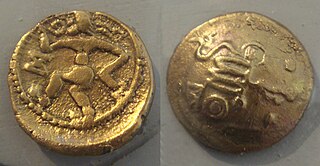
Gallia Aquitania, also known as Aquitaine or Aquitaine Gaul, was a province of the Roman Empire. It lies in present-day southwest France, where it gives its name to the modern region of Aquitaine. It was bordered by the provinces of Gallia Lugdunensis, Gallia Narbonensis, and Hispania Tarraconensis.

The Taurini were a Celto-Ligurian tribe dwelling in the upper valley of the river Po, around present-day Turin, during the Iron Age and the Roman period.

The Aquitani were a tribe that lived in the region between the Pyrenees, the Atlantic Ocean, and the Garonne, in present-day southwestern France in the 1st century BCE. The Romans dubbed this region Gallia Aquitania. Classical authors such as Julius Caesar and Strabo clearly distinguish the Aquitani from the other peoples of Gaul, and note their similarity to others in the Iberian Peninsula.

The Turoni or Turones were a Gallic tribe of dwelling in the later Touraine region during the Iron Age and the Roman period.
The Medulli were a Gallic tribe dwelling in the upper valley of Maurienne, around present-day Modane (Savoie), during the Iron Age and Roman period.

The Parisii were a Gallic tribe that dwelt on the banks of the river Seine during the Iron Age and the Roman era. They lived on lands now occupied by the modern city of Paris, whose name is derived from the ethnonym.

The Lemovīcēs were a Gallic tribe dwelling in the modern Limousin region during the Iron Age and the Roman period.
The Seduni were a Gallic tribe dwelling in the upper Rhône valley, around present-day Sion, during the Iron Age and the Roman period.
The Nantuates or Nantuatae were a Gallic tribe dwelling around present-day Massongex, in the modern Canton of Valais (Switzerland) and adjacent areas of France, during the Iron Age and the Roman period.
The Ceutrones were a Gallic tribe dwelling in the Tarantaise Valley, in modern Savoie, during the Iron Age and Roman period.
The Salassi or Salasses were a Gallic or Ligurian tribe dwelling in the upper valley of the Dora Baltea river, near present-day Aosta, Aosta Valley, during the Iron Age and the Roman period.

The Bituriges Vivisci were a Gallic tribe dwelling near modern-day Bordeaux during the Roman period. They had a homonym tribe, the Bituriges Cubi in the Berry region, which could indicate a common origin, although there is no direct of evidence of this.

The Namnetes were a Gallic tribe dwelling near the modern city of Nantes during the Iron Age and the Roman period.

The Elusates were an Aquitani tribe dwelling in the modern Gers department, around present-day Eauze, France during the Iron Age and the Roman period.

The Cocosates or Cocosates Sexsignani were an Aquitani tribe dwelling in present-day Landes during the Iron Age.

The Sotiates were a Gallic-Aquitani tribe dwelling in the region surrounding the modern town of Sos (Lot-et-Garonne) during the Iron Age and the Roman period.

The Auscii or Ausci were an Aquitani tribe dwelling around present-day Auch during the Iron Age.

The Bigerriones or Begerri were an Aquitani tribe dwelling in present-day Bigorre during the Iron Age.
The Vennones or Vennonetes were a Rhaetian tribe dwelling in the northern Alps, between Chur and Lake Constance, during the Iron Age and the Roman era.
The Ucennii,Ucenni or Iconii were a Gallic tribe dwelling in the Romanche valley, in the Alps, during the Iron Age.








